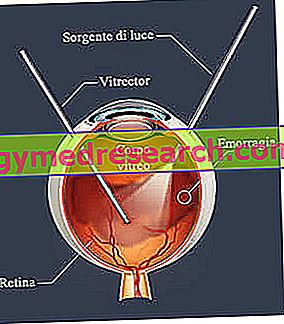Generality
Vitrectomy is the surgical procedure which removes a portion or the entirety of the vitreous humor (or vitreous body) present inside the vitreous chamber of the eye.

Preparation for surgery is quite simple: there are some clinical controls and compliance with simple rules, in view of general anesthesia.
The procedure for removing the vitreous humor generally lasts 1-2 hours; at the end, at least one day of hospitalization is foreseen, during which the patient is visited periodically.
The risks of a vitrectomy are different and, in some cases, not at all negligible.
The results of such an intervention depend very much on the conditions that made it necessary to carry it out.
Short review of the anatomy of the eye
In the eye (or eyeball ) three concentric portions can be recognized, which, from the outside towards the inside, are:
- The external tunic, which acts as an attack for the so-called extrinsic muscles of the eyeball; in it reside sclera (anteriorly) and cornea (posteriorly). It has a fibrous nature.
- The medium cassock (or uvea ), which is a membrane of connective tissue, rich in blood vessels and pigment.
Interposed between sclera and retina, it deals with providing nourishment to the retina, or rather to the layers of retina with which it comes into contact.
Includes iris, ciliary body and choroid.
- The inner robe, which is formed by the retina.
The retina is a transparent film consisting of ten layers of nerve cells (real neurons), including the so-called cones and rods. Cones and rods are deputies to the visual function.
The internal habit, as can be guessed from what has just been said, has a nervous nature.

Figure: the vitreous humor resides in a cavity called the vitreous chamber. The vitreous chamber is posterior to the crystalline and iris, but anterior to the retina.
The main function of the vitreous humor is to provide support to the structures of the eyeball with which it is in contact.
Unlike the aqueous humor (a substance present in the so-called anterior chamber of the eye), the vitreous humor is not involved in the regulation of eye pressure.
What is vitrectomy?
Vitrectomy is the surgical procedure aimed at the total or partial removal of the vitreous humor (or vitreous body ).
The vitreous humor is a gelatinous and transparent substance, contained within the eye - to be exact in the so-called vitreous chamber - and interposed between the crystalline lens and the retina .
UMOR VITREO: SOME ADDITIONAL INFORMATION
The position and consistency of the vitreous humor allow it to act as a support substance for the crystalline lens, at the front of the eyeball, and for the retina, at the back of the eye.
Colorless and with a constant volume, the vitreous humor is made up of 98-99% water and other substances such as: hyaluronic acid, salts, sugars, vitrosine (a type of collagen, therefore a protein), opticine (a protein), type II collagen and other proteins.
Thanks to this composition, the vitreous body allows the eye to maintain its spherical shape.
It is devoid of blood vessels and is crossed by the hyaloid canal, which goes from the optic papilla (or the emergence of the optic nerve inside the eyeball) to the hyaloid fossa (ie the posterior part of the crystalline lens).
When you run
Vitrectomy may be necessary in the presence of:
- A problem with the retina or macula (central part of the retina) . The presence of holes or tears on the retina, macular holes, retinal detachment and macular pucker requires the removal of the vitreous humor, in order to correctly perform the repair operation.
In all these cases, therefore, vitrectomy is a part of a much wider and more complex surgical procedure.
- Reduced vision due to blood loss in the blood vessels supplying the retina. This phenomenon is more properly called vitreous hemorrhage .
Vitrectomy is performed to re-establish, at least in part, the visual abilities.
- A foreign body inside the vitreous body or near the retina . Such a condition can occur, for example, after an eye injury.
In such circumstances, vitrectomy is used to remove the foreign object present in the eye.
- Proliferating retinopathy . It is a retina suffering, typical of people with diabetes and characterized by the continuous formation of blood vessels at the retinal level. These vessels are fragile, abnormal and tend to cause bleeding (hemorrhages).
In such situations, vitrectomy is performed to allow a particular laser treatment, which is used to eliminate abnormal blood vessels.
- Serious eye infections . In these situations, vitrectomy is the prelude to an ocular biopsy, that is, the collection and analysis in the laboratory of a particular eye tissue.
Preparation
Before vitrectomy, the doctor who will take care of the intervention (or a collaborator) must visit the patient and investigate some fundamental aspects, such as: clinical history, ocular health and medications taken.
Furthermore, cataract risk assessment is equally important. In fact, vitrectomy is a factor favoring the opacification (partial or total) of the lens.
Clinical history: what is it?
Analyzing an individual's medical history means gathering as much information as possible about: illnesses suffered in the past, current illnesses, allergies to particular substances or drugs, etc.
PRE-OPERATIONAL TESTS AND RECOMMENDATIONS
Generally, vitrectomy is performed under general anesthesia .
Therefore, to make sure that the latter does not involve complications, the patient is subjected to blood tests and an electrocardiogram ; furthermore, it is recommended to:
- On the day of the procedure, appear at full fast since at least the previous evening.
- After the operation, be assisted by a trusted person for at least 12-24 hours. This recommendation is explained by the fact that, for several hours after general anesthesia, patients feel confused and show an evident slowing down of their ability to react.
Procedure
Once the patient has been anesthetized, the attending physician - to be precise an ophthalmologist - begins the vitrectomy operation, making small cuts of about one millimeter at the level of the sclera (the white part of the eye).
These cuts are indispensable for the insertion, in the vitreous chamber, of instruments for the suction of the gelatinous substance constituting the vitreous humor.
Once the vitreous body has been removed, the following operations will be carried out: in the event of a retina problem, it will be repaired; in the case of proliferating retinopathy, laser treatment will be used to eliminate abnormal blood vessels; and so on.
DURATION OF THE INTERVENTION
Vitrectomy usually lasts 1-2 hours . However, if the subsequent operations are particularly delicate, it could also last for 3 hours .
TEMPORARY SUBSTITUTION OF THE VOR THE MOOD
Premise: once eliminated, the vitreous humor never reforms again; its place is occupied, over time, by the aqueous humor (the same present in the anterior cavities of the eyeball), which admirably fulfills the same support functions.
After vitrectomy interventions for a retina problem, it is necessary to provide for the insertion of something that, immediately, takes the place of vitreous humor and preserves the retina just made from possible insults, detachments, etc. It is a temporary remedy, waiting for the retina to heal completely and for the aqueous humor to fill the vitreous chamber.
In place of the vitreous humor, the ophthalmologist can insert:
- A gas bubble .
Advantages. This solution is very practical, because the air bubble is absorbed naturally by the body within several days.
Disadvantages. Air bubbles tend to move very easily and no longer provide adequate protection. For this to take place, the patient is required to keep his face down for most of the day and to sleep on one side only.
In cases like these, to know the exact positions to be taken and avoided, it is advisable to consult thoroughly with the attending ophthalmologist.
Generally gas bubbles are not recommended for young patients or, in any case, with a life that is still very active.
- A special silicone oil .
Advantages. Unlike gas bubbles, the oil moves very little, so it is rare for it to leave the operated retina uncovered. It is a solution particularly suited to young patients, children and in general to all those who still have a fairly active life.
Disadvantages. Since it is not reabsorbed naturally like gas bubbles, silicone oil can only be removed by resorting to a small ad hoc surgery.
If the gas bubble moves
When the air bubble moves from its position close to the retina, it increases the risk of cataracts, an increase in eye pressure and / or damage to the cornea.
Post-operative phase
Generally, a patient undergoing vitrectomy is held in the hospital for at least one night, for reasons of precaution. During this time, medical personnel reserve the right to visit the person operated from time to time, monitoring his vital parameters.
For the first time, the vision is likely to be blurred; generally, blurring lasts from 4 to 6 weeks.
Moreover, for at least a couple of weeks, the operated eye appears to be particularly sensitive, swollen and reddened.
EYE DROPS
To prevent infections, reduce inflammation and accelerate the healing of the operated eye, ophthalmologists prescribe some eye drops that the patient is able to self-administer.
WHEN TO CONTACT THE DOCTOR
Blurred vision, swelling and ocular redness are normal phenomena, for which we should not be particularly alarmed.
Instead, contact your doctor immediately if you are subject to:
- Fall in sight
- Increased pain instead of its reduction
- Increased eye redness and swelling around the operated eye
- Unusual loss of fluid from the operated eye
- Changes in the visual field or appearance of flashes in the eyes
Risks of vitrectomy
There are several risks of vitrectomy intervention. Here is what they consist of:
- Increased eye pressure. This phenomenon occurs more frequently in patients with glaucoma.
- Vitreous hemorrhage
- Retinal detachment
- Corneal edema. It is a condition characterized by the accumulation of fluid at the level of the cornea; this accumulation is generally due to an inadequate drainage mechanism of the liquid surrounding the cornea.
- Intraocular infection (or endophthalmitis). It involves the inflammation of the internal structures of the eye.
- Cataract. According to some scientific studies, in people undergoing vitrectomy, the tendency to cataract would increase by 30-40%.
Results
The results of a vitrectomy depend very much on the condition that made it necessary to perform it. For example, in cases of vitreous hemorrhage, the intervention of removal of the vitreous body can also lead to the complete restoration of the visual faculties; on the contrary, in the presence of severe retinal problems, vitrectomy may involve only a minimal improvement in vision, just enough for a safe walk.
Therefore, to conclude, we must not forget that the successful outcome of a vitrectomy also depends on the scrupulous attention given to post-operative advice from the attending physician.



